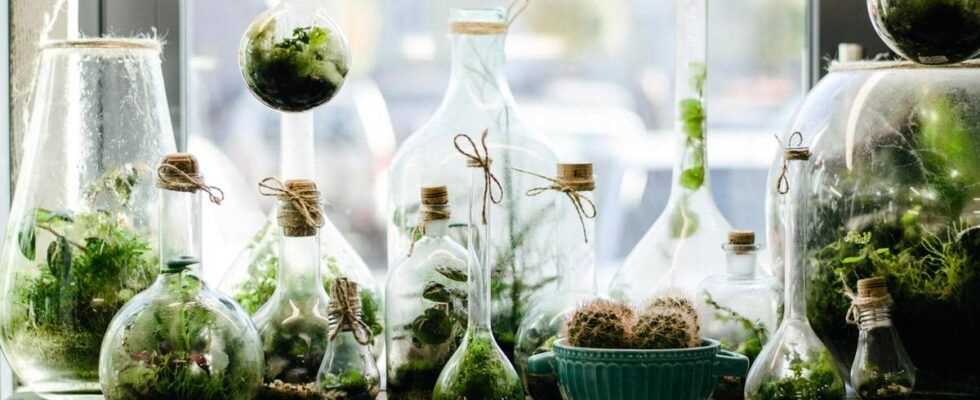Plant lovers who are not blessed with a green thumb should now be able to breathe a sigh of relief: a bottle garden does not need any maintenance because it is based on a self-contained ecosystem. So you can enjoy a green home without any effort!
What is a bottle garden?
A bottle garden is a closed circulatory system in a glass. The Content from substrate, earth, microorganisms, plants, air and water creates an ecosystem in the container that requires no further maintenance and can be maintained for years. All the necessary conditions for the growth of the plants are in place so that it keeps itself alive. A bottle garden is also called Florarium or eternal terrarium.
How does the bottle garden work?
A bottle garden needs almost no additional maintenance: only when setting up a garden does it need to be watered once. This water is absorbed by the plant through the roots and released through the leaves. By condensation The water droplets on the glass wall return to the floor and the cycle starts again. In addition, live in the bottle garden Destructors (Decomposer) who Degrade dead plant material and consume oxygen and release carbon dioxide and nutrients. The plant in turn needs the nutrients and takes Carbon dioxide that she is using Converts water and light energy into oxygen and glucose. This natural material cycle is a perfectly balanced system that supplies everyone involved with the necessary substances to survive.
How to create a bottle garden
You need:
- Large glass jar: Bulbable and closable models, such as candy jars, are particularly suitable
- Drainage layer: clay granulate, pebbles or brick chips
- Two tablespoons of pieces of charcoal (activated carbon or charcoal): best shred them in a bag with a hammer
- Sowing soil
- Exotic plants: The bottle garden has a warm, humid climate that is suitable for many houseplants that grow slowly. For example, mini orchids, peat moss, small ferns, bromeliads, carnivorous plants, ufo plants, small-leaved ivy. You can use cuttings or offshoots.
- Aids for filling: cardboard roll, funnel, long wooden sticks, long spoon
Caution: Succulents or cacti are not suitable for a closed bottle garden. You should use an open container for these plants.
Create a bottle garden:
- Thoroughly clean the glass bottle or glass jar. Use boiling water for this. This will ensure that mold spores and germs in the glass are removed. Let the jar dry.
- Carefully give that Drainage layer on the entire vessel base (up to five centimeters). This layer later prevents waterlogging.
- Spread the Charcoal about that. It prevents mold growth.
- Fill one Layer of dry earth above (up to ten centimeters). To prevent the glass wall from becoming so dirty, you can use a wide funnel (e.g. a cardboard roll) to fill it.
- Place your plants in the bottle garden. Long aids (long spoons) can be useful for this. Form a small hollow, insert the offshoot or the plant and press it down gently. You can put several plants in the bottle garden. Just make sure it doesn't get too tight. If you use plants from a nursery pot, carefully remove the plants and shake the soil well beforehand.
- Cover the rest of the earth with living mosses and decorative elements of your choice (e.g. shells, branches, stones).
- It is best to moisten your bottle garden with an atomizer. Use low in lime, lukewarm water (e.g. rainwater). Water must not build up on the ground, but the earth should still be moistened. It is advisable to pour in stages. If your bottle garden is too damp, you can leave it open for a few more days. The moisture will evaporate.
- Then seal the container airtight.
Bottle garden: location and maintenance
- Place your bottle garden in front of one bright place. However, make sure that your plants are not exposed to the direct sun, otherwise they could burn.
- To avoid mold growth, you can open the bottle garden from time to time.
- If there are optimal conditions in the bottle garden, it often no longer needs to be watered, or only very rarely. Decide as needed.
- You should remove rotting plant parts.
Looking for more garden and plant tips? Here you will learn how to plant herbs. How to repot a plant and what the Urban Jungle trend is all about.
If you want to share garden tips with others, have a look at our community.
